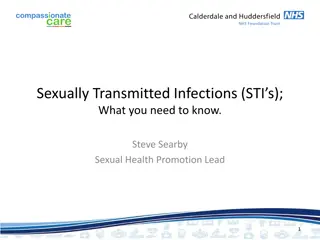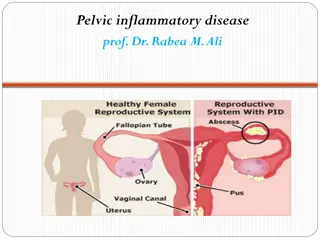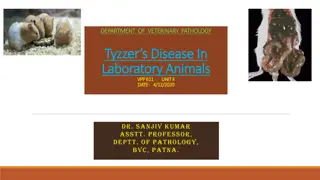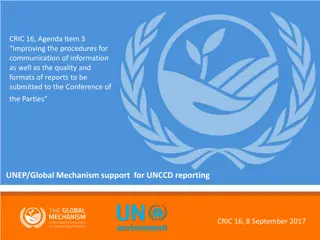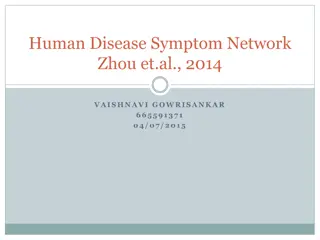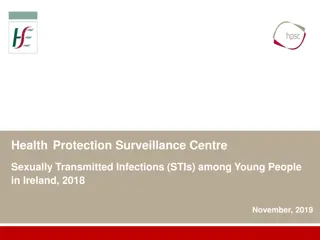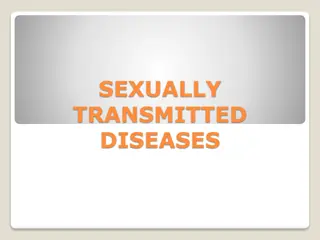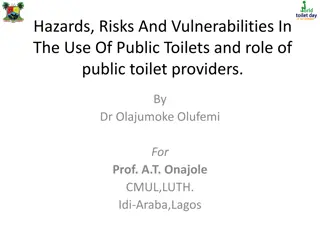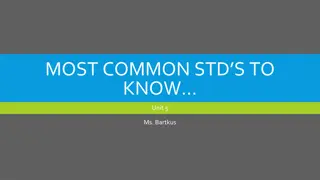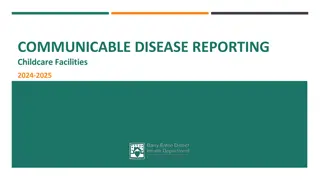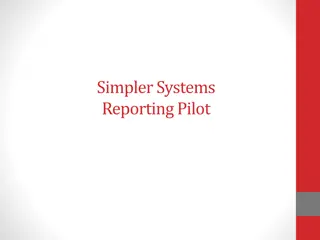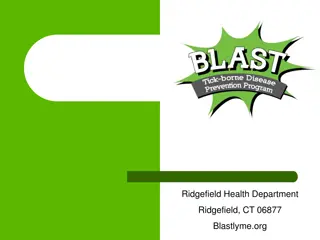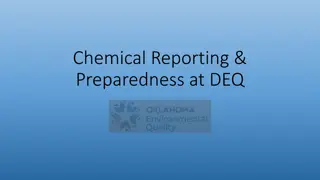Sexually Transmitted Disease Reporting
Join this informative webinar for healthcare providers to learn about reporting, surveillance, and control of sexually transmitted diseases (STDs). Explore topics like reportable STIs, lab results, counseling, partner services, disease surveillance, and more.
Download Presentation

Please find below an Image/Link to download the presentation.
The content on the website is provided AS IS for your information and personal use only. It may not be sold, licensed, or shared on other websites without obtaining consent from the author.If you encounter any issues during the download, it is possible that the publisher has removed the file from their server.
You are allowed to download the files provided on this website for personal or commercial use, subject to the condition that they are used lawfully. All files are the property of their respective owners.
The content on the website is provided AS IS for your information and personal use only. It may not be sold, licensed, or shared on other websites without obtaining consent from the author.
E N D
Presentation Transcript
Sexually Transmitted Disease Reporting Sexually Transmitted Disease Reporting Webinar for Providers Webinar for Providers Monica Kowalczyk STD Surveillance Specialist Intern
Reportable STIs & Lab Results STI Provider Reporting Fines & Penalties Counseling & Partner Services Physical Exam & Medical Treatment for STIs Expedited Partner Therapy PART 693 - CONTROL OF SEXUALLY TRANSMISSIBLE INFECTIONS CODE
Disease Surveillance & Follow-up Reportable STDs Quickly Identify diseases requiring immediate intervention Chlamydia Detect changes in trends or patterns in disease occurrence Gonorrhea Identify at-risk communities/population groups that require targeted public health response Syphilis Assess strategies, evaluate outcomes, and determine success, of control and prevention interventions Chancroid Lymphogranuloma Venereum (LGV)
How LHDs use Provider-Reported STD Information Assist IDPH Surveillance & Epidemiological Monitoring Control Sources of Exposure Prevent the Spread of STDS appropriate treatment provided to all STD- positive cases case analysis contact tracing & partner services education & counseling linkage to care Complete disposition requirements & send closed investigations to IDPH
How CDC uses Provider-Reported STD Information CDC receives National Notifiable Diseases Surveillance System (NNDSS) data in multiple formats from state and territorial health departments and combines these data streams into unified datasets for CDC programs. CDC programs use disease-specific data to Recognize disease outbreaks Track disease spread at state, regional, and national levels Identify geographic areas of concern and inform state decision makers Identify high-risk groups Assist state and local public health departments better control disease by Evaluate and fund disease control activities
How CDC uses Provider-Reported STD Information cont. CDC provides case surveillance resources and guidance to patients, healthcare teams, and public health agencies. Health information for patients (websites, fact sheets, toolkits) Guidance to healthcare teams (clinical information, research, publications like Morbidity and Mortality Weekly Report (MMWR), Support to public health agencies (guidance, data collection and reporting, large and small-scale outbreak assistance, and funding)
1) Sexual History and Physical Examination 2) Prevention Recommendations for Providing Quality STD Clinical Services (STD QCS) 3) Partner Services (notification & care of sex partners; EPT) 4) Screening 5) Evaluation of STD-related Conditions 6) Laboratory Tests 7) Treatments 8) Education on preventing new infection
The most important intervention for all STDs is treatment. It is critical that treatment is provided and reported in accordance with current practice standards: 2021 STI Treatment Guidelines 2022 IDP Morbidity Report of STIs 2022 STD Treatment Codes Expedited Partner Therapy (EPT) Importance of Treatment & Current Practice Standards 2021 STI Treatment Guidelines | 2022 STI Morb Report & Rx Codes | Expedited Partner Therapy
Updated Treatment Guidelines Updated Treatment Guidelines RecommendationsandReports/ Vol.70/No.4 July23,2021 Sexually Transmitted Infections Treatment Guidelines, 2021 2021 STI Treatment Guidelines comprises current, evidence-based prevention, diagnostic and treatment recommendations as a source for clinical guidance *2021 treatment guidelines replace those of 2015 U.S. Department of Health and Human Services Centers for Disease Control and Prevention 2021 STI Treatment Guidelines | 2022 STI Morb Report & Rx Codes | Expedited Partner Therapy
Updated Updated Treatment Treatment Codes Codes *2022 treatment codes replace those of 2018 2021 STI Treatment Guidelines | 2022 STI Morb Report & Rx Codes | Expedited Partner Therapy
Expedited Partner Therapy (EPT) Expedited Partner Therapy (EPT) The clinical practice of treating the sex partners of patients diagnosed with chlamydia or gonorrhea by providing prescriptions or medications to the patient to take to his/her partner without the health care provider first examining the partner. EPT Works standard of care and endorsed by CDC proven to reduce re-infection rates and possible health complications effective tool to combat the rising STD rates useful option to facilitate partner treatment 2021 STI Treatment Guidelines | 2022 STI Morb Report & Rx Codes | Expedited Partner Therapy
Reporting Patient Info Reporting Patient Info Reporting Treatment Reporting Treatment Date(s) treated Rx code(s) Treatment facility Expedited partner therapy (yes/no) Attempts to notify patient of positive test Patient first & last name Residential address DOB Phone number Race Ethnicity Sex at birth Current gender Sex of sex partner(s) For female patients - whether they are pregnant, and if so, estimated due date 2021 STI Treatment Guidelines | 2022 STI Morb Report & Rx Codes | Expedited Partner Therapy
Reporting Options Reporting Options Illinois' National Electronic Disease Surveillance System IDPH Morbidity Report Form
IDPH Morbidity Report IDPH Morbidity Report of Sexually Transmitted of Sexually Transmitted Infections Infections fax: (630) 897 fax: (630) 897- -8128 8128 2021 STI Treatment Guidelines | 2022 STI Morb Report & Rx Codes | Expedited Partner Therapy
STD Reporting Methods Diagram STD Reporting Methods Diagram Reporting through I-NEDSS replaces forms and faxing by enabling providers to report positive results & treatment directly into the disease surveillance system
What is I What is I- -NEDSS? NEDSS? Illinois National Electronic Disease Surveillance System (I-NEDSS) is a secure, Web-based application available to health care providers and other reporters for input of demographic, medical and exposure information on patients diagnosed with reportable conditions. 2021 STI Treatment Guidelines | 2022 STI Morb Report & Rx Codes | Expedited Partner Therapy
Why Use I Why Use I- -NEDSS? NEDSS? Optimizes STD reporting process Replaces manual forms & faxing Allows sensitive information to be shared safely & efficiently between providers & LHD Allows sensitive information to be shared safely & efficiently with IDPH & CDC 2021 STI Treatment Guidelines | 2022 STI Morb Report & Rx Codes | Expedited Partner Therapy
Register for I Register for I- - NEDSS NEDSS IDPH Web Portal
IDPH Web IDPH Web Portal User Portal User Agreement Agreement
IDPH Web Portal User IDPH Web Portal User Registration Form Registration Form I-NEDSS reporting STI treatment to LHD Portal Registration Portal Registration Authority (PRA) List Authority (PRA) List
KCHD Communications KCHD Communications KHDC will Run monthly case reports to identify positive-STD cases that are missing report of treatment Conduct follow-up with providers who have cases pending report of treatment for any positive chlamydia / gonorrhea lab results received KCHD STD Surveillance Specialist Adriana Posada | posadaadriana@co.kane.il.us | phone (630) 444-3099 | fax (630) 897-8128
Contact Information Referenced Links Kane County Health Department Current Practice Standards 2021 STI Treatment Guidelines (630) 208-3801 (630) 897-8128 2022 STI Morb Report & Rx Codes Expedited Partner Therapy KCHD STD Surveillance Specialist PART 693 - CONTROL OF SEXUALLY TRANSMISSIBLE INFECTIONS CODE Adriana Posada Recommendations for Providing Quality STD Clinical Services (STD QCS) (630) 444-3099 (630) 897-8128 PosadaAdriana@co.kane.il.us I-NEDSS Illinois National Electronic Disease Surveillance System (I-NEDSS) I-NEDSS Portal Registration IDPH Web Portal DPH.security@Illinois.gov Web Portal User Agreement (217) 557-5496





